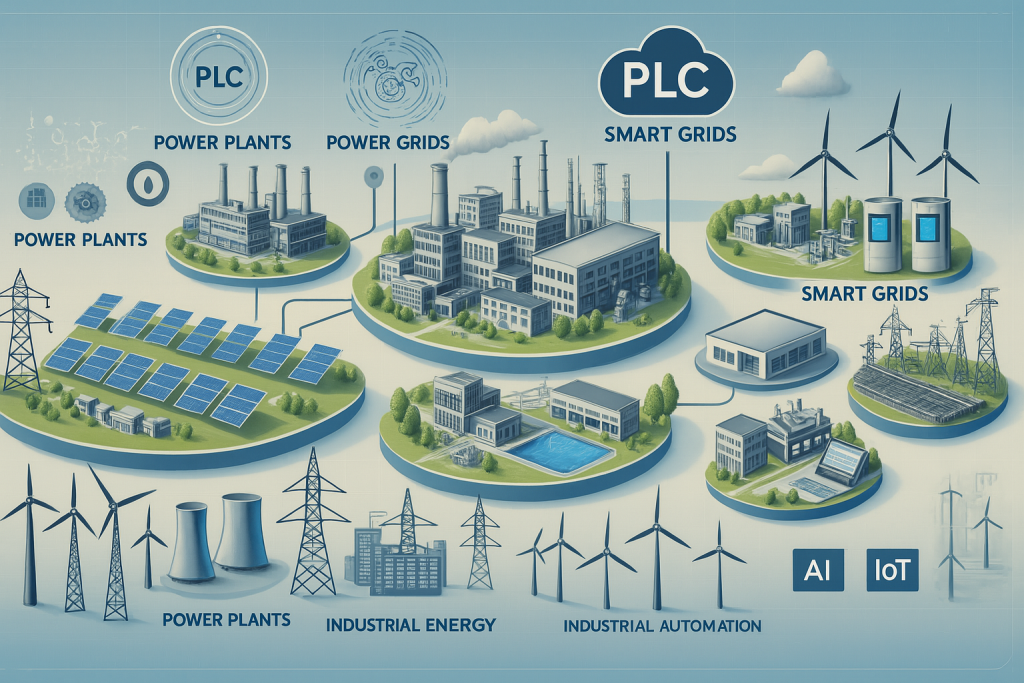PLC Applications in Energy Management
Energy management is one of the most critical areas in modern industries, ensuring that energy is used efficiently, sustainably, and cost-effectively. Programmable Logic Controllers (PLCs) play a key role in monitoring, controlling, and optimizing energy usage across various sectors, including power plants, smart grids, industrial manufacturing, and building automation.

With the rise of Industry 4.0 and IoT, PLCs are being integrated with real-time monitoring systems, AI-based predictive analytics, and smart grids to enhance energy efficiency and reduce carbon footprints. This page explores the applications, benefits, real-world examples, and future trends of PLC-based energy management systems.
1. The Role of PLCs in Energy Management
PLCs enhance energy efficiency by automating power distribution, optimizing usage, and integrating with renewable energy sources. The main objectives of PLC-based energy management include:
- Reducing energy waste – Optimizing processes to cut unnecessary power consumption
- Enhancing grid reliability – Monitoring energy flow for better power distribution
- Enabling smart automation – Using real-time data to improve efficiency
- Integrating with renewable sources – Managing solar, wind, and hydro energy systems
Example: A manufacturing facility integrates PLCs with smart sensors to monitor real-time energy consumption, automatically adjusting machine operations to reduce peak demand costs.
2. Key Applications of PLCs in Energy Management
A. Power Plant Automation & Load Management
PLCs are widely used in power generation plants to control turbines, boilers, and generators, ensuring stable electricity production.
PLC-Controlled Power Plant Functions:
- Real-time load balancing – Distributes power efficiently across the grid
- Automatic power factor correction (APFC) – Reduces energy losses and enhances efficiency
- Peak demand management – Prevents overloading during peak hours
Example: Germany’s renewable energy plants use PLCs to adjust turbine speeds based on wind and solar availability, improving grid stability.
B. Smart Grid & Renewable Energy Integration
PLCs facilitate the integration of renewable energy sources into power grids, ensuring a smooth transition between traditional and green energy.
PLC-Enabled Smart Grid Features:
- Automatic switching between solar, wind, and conventional power sources
- Real-time data collection on voltage, current, and power quality
- Demand-response management for balancing supply and demand
Example: Denmark’s smart grid uses PLCs to optimize wind power distribution based on real-time demand forecasts.
C. Industrial Energy Monitoring & Efficiency Optimization
Industries consume large amounts of energy. PLCs automate lighting, motors, HVAC, and production lines to reduce waste and improve performance.
PLC-Based Industrial Energy Management Features:
- Automated machine shutdown during non-peak hours
- Optimized motor control using Variable Frequency Drives (VFDs)
- Energy usage monitoring via IoT-integrated sensors
Example: A steel plant in Japan reduced energy costs by 25% using PLC-controlled VFDs for motor speed adjustment.
D. Building Automation & Smart Energy Systems
Modern buildings use PLC-controlled systems to optimize HVAC, lighting, and energy usage for increased efficiency and lower costs.
PLC-Based Smart Building Energy Solutions:
- Automatic temperature regulation in HVAC
- Motion-activated lighting and energy-efficient scheduling
- Remote monitoring and consumption analytics
Example: Dubai’s Burj Khalifa uses PLCs to control lighting and HVAC, reducing energy consumption by 30%.
E. Solar & Wind Energy System Management
PLCs help manage solar panels, wind turbines, and battery systems to maximize renewable energy output and reliability.
How PLCs Optimize Renewable Energy Systems:
- Solar panel tracking for maximum energy absorption
- Wind turbine control based on wind speed variations
- Battery energy storage management for uninterrupted supply
Example: A solar power plant in California uses PLCs to dynamically adjust panel angles, improving energy capture by 22%.
3. Real-World Examples of PLC-Based Energy Management
A. Smart Industrial Power Management
Example: Tesla’s Gigafactory in Nevada uses PLC automation to optimize energy use and integrate onsite solar with battery storage.
B. Grid Automation for Renewable Energy
Example: Norway’s hydropower stations use PLCs to balance water flow, ensuring stable and efficient electricity generation.
C. Energy-Efficient Smart Cities
Example: Singapore’s smart city initiative uses PLC-controlled LED streetlights that adjust brightness based on real-time traffic flow.
4. Future Trends in PLC-Based Energy Management
- AI-Driven Predictive Maintenance – Detecting equipment failures before breakdowns
- Blockchain in Energy Transactions – Enabling secure, decentralized energy trading
- Wireless PLC Networks – Reducing costs in distributed energy systems
- Hydrogen & Battery Storage Integration – Improving efficiency in clean energy storage
- EV Charging Infrastructure – PLCs managing automated fast-charging networks
Example: Germany’s hydrogen plants use PLCs for real-time electrolysis control, enhancing clean energy conversion rates.
5. Benefits of Using PLCs in Energy Management
- Lower Energy Costs – Reducing waste and improving efficiency
- Enhanced Grid Stability – Enabling smart, automated distribution
- Seamless Renewable Energy Integration – Supporting wind, solar, and hydro systems
- Remote Monitoring & Automation – Reducing manual intervention
- Sustainable Energy Solutions – Lowering carbon emissions
Example: Google’s data centers use PLC-integrated cooling systems to reduce power consumption by 40%.
Conclusion
PLCs revolutionize energy management by optimizing power usage across industries, smart grids, and renewable energy systems. With AI, IoT, and smart automation, PLCs make modern energy systems more efficient, cost-effective, and sustainable.
Key Takeaways:
- PLCs optimize energy use in power plants, smart grids, and industries
- They support renewable integration and enable real-time automation
- Future trends include AI-driven automation and decentralized energy grids
